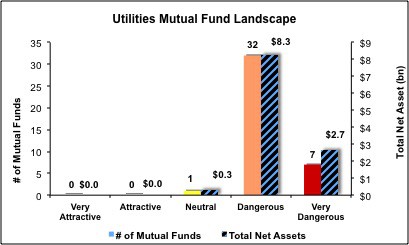The Utilities sector ranks ninth out of the ten sectors as detailed in my sector rankings for ETFs and mutual funds. It gets my Dangerous rating, which is based on aggregation of ratings of eight ETFs and 40 mutual funds in the Utilities sector as of October 11, 2012. Prior reports on the best & worst ETFs and mutual funds in every sector and style are here.
Figure 1 ranks from best to worst all eight Utilities ETFs and Figure 2 shows the five best and worst-rated Utilities mutual funds. Not all Utilities sector ETFs and mutual funds are created the same. The number of holdings varies widely (from 22 to 80), which creates drastically different investment implications and ratings. The best ETFs and mutual funds allocate more value to Attractive-or-better-rated stocks than the worst ETFs and mutual funds, which allocate too much value to Neutral-or-worse-rated stocks.
To identify the best and avoid the worst ETFs and mutual funds within the Utilities sector, investors need a predictive rating based on (1) stocks ratings of the holdings and (2) the all-in expenses of each ETF and mutual fund. Investors need not rely on backward-looking ratings. My fund rating methodology is detailed here.
Investors should not buy any Utilities ETFs or mutual funds because none get an Attractive-or-better rating. If you must have exposure to this sector, you should buy a basket of Attractive-or-better rated stocks and avoid paying undeserved fund fees. Active management has a long history of not paying off.
Get my ratings on all ETFs and mutual funds in this sector on my free mutual fund and ETF screener.
Figure 1: ETFs with the Best & Worst Ratings

Sources: New Constructs, LLC and company filings
Figure 2: Mutual Funds with the Best & Worst Ratings – Top 5

Sources: New Constructs, LLC and company filings
First Trust Utilities AlphaDEX Fund (FXU) is my top-rated Utilities ETF and earns my Dangerous rating. American Century Quantitative Equity Funds, Inc: Utilities Fund (BULIX) is my top-rated Utilities mutual fund and earns my Neutral rating.
Rydex S&P Equal Weight Utilities ETF (RYU) is my worst-rated Utilities ETF and earns my Dangerous rating. Rydex Series Funds: Utilities Fund (RYUTX) is my worst-rated Utilities mutual fund and earns my Very Dangerous rating.
Figure 3 shows that eight out of the 135 stocks (4% of the total net assets) held by Utilities ETFs and mutual funds get an Attractive-or-better rating. However, none of the eight Utilities ETFs or 40 Utilities mutual funds get an Attractive-or-better rating.
The takeaways are: mutual fund managers allocate too much capital to low-quality stocks and Utilities ETFs hold poor quality stocks.
Figure 3: Utilities Sector Landscape For ETFs, Mutual Funds & Stocks
As detailed in “Cheap Funds Dupe Investors”, the fund industry offers many cheap funds but very few funds with high-quality stocks, or with what I call good portfolio management.
Investors need to tread carefully when considering Utilities ETFs and mutual funds, as none are rated Attractive or better. Focus on individual stocks instead.
Public Service Electric & Gas Company (PEG) is one of my favorite stocks held by Utilities ETFs and mutual funds and earns my Attractive rating. PEG is a rarity in the Utilities sector – it is in the only company in the Utilities sector to earn an Attractive-or-better rating, and is a business with positive economic earnings and a cheap valuation. PEG has generated a return on invested capital (ROIC) above its weighted average cost of capital (WACC) in five of the last six years. Its current stock price (~$32.48) implies the company’s after-tax profits (NOPAT) will permanently decline by 30%. The market is setting a low bar, and PEG has demonstrated that it can grow NOPAT.
Integrys Energy Group, Inc. (TEG) is one of my least favorite stocks held by Utilities ETFs and mutual funds and earns my Very Dangerous rating. TEG is a value destroyer that has generated negative economic earnings for all but one of the last 15 years. To justify its current stock price (~$55.29), TEG must increase profits by 9.5% compounded annually for the next 15 years. Growth like this is unlikely given the history of poor performance, a mature market, and the regulation faced by all Utilities.
88 stocks of the 3000+ I cover are classified as Utilities stocks, but due to style drift, Utilities ETFs and mutual funds hold 135 stocks.
Figures 4 and 5 show the rating landscape of all Utilities ETFs and mutual funds.
Our sector rankings for ETFs and mutual funds report ranks all sectors and highlights those that offer the best investments.
Figure 4: Separating the Best ETFs From the Worst ETFs
Figure 5: Separating the Best Mutual Funds From the Worst Mutual Funds
Review my full list of ratings and rankings along with reports on all eight ETFs and 40 mutual funds in the Utilities sector.
Disclosure: I receive no compensation to write about any specific stock, sector or theme.



